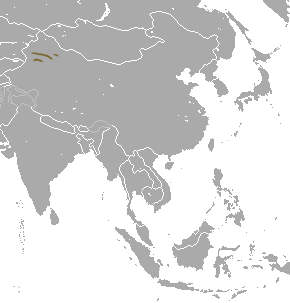Ili pika facts for kids
Quick facts for kids Ili pika |
|
|---|---|
| Conservation status | |
| Scientific classification | |
| Genus: |
Ochotona
|
| Species: |
iliensis
|
 |
|
| Ili pika range | |
The Ili pika (Ochotona iliensis) is a super rare mammal that lives only in northwest China. It's a small animal, kind of like a short-eared rabbit. Scientists first found it in 1983.
Sadly, the Ili pika is now an endangered species. There are probably fewer than 1,000 left in the world. Its numbers have dropped a lot, likely because of warmer temperatures from climate change and more animals eating its food.
Contents
What is an Ili Pika?
The Ili pika looks a bit like a rabbit with short ears. It's quite big for a pika, growing to about 20 centimeters (8 inches) long. It can weigh up to 250 grams (about half a pound).
This pika has bright fur. It also has cool rusty-red spots on its forehead, the top of its head, and the sides of its neck.
Where Do Ili Pikas Live?
Ili pikas live only in the Tian Shan mountains. These mountains are in the northwest part of China's Xinjiang province. This means they are endemic to that area, found nowhere else on Earth.
Sadly, recent studies suggest that Ili pikas might have disappeared from some parts of these mountains. This includes places like the Jilimalale and Hutubi South Mountains.
Ili Pika Habitat
Ili pikas make their homes on rocky slopes high up in the mountains. They usually live at elevations from about 2,800 to 4,100 meters (9,200 to 13,500 feet). They like places with slightly sloped rock walls or cliffs. These areas have gaps or holes that the pikas use as their dens.
Ili Pika Lifestyle and Behavior
The Ili pika is a herbivore, meaning it eats plants. It mainly feeds on grasses and other small plants. They often collect plants and pile them up, like making little haystacks for food.
Not much is known about how these pikas behave. They usually come out during the day, but sometimes they are active at night too. They are mostly solitary animals, meaning they live alone. Unlike some other pikas, they don't make many sounds.
Daily Activity Changes
Ili pikas change when they are active depending on the season. In winter, they are more active during the day. But in spring and fall, they tend to be more active at night.
Ili Pika Reproduction
Ili pikas have a low reproduction rate. During their breeding season, a mother pika usually has two litters of babies. Each litter typically has two young. However, often only one of these litters is successful.
The second litter is usually conceived soon after the first. By then, the mother's body might not have enough energy or resources left. Because of this, the second litter is often abandoned, as the mother cannot care for them.
Why the Ili Pika is Endangered
A conservationist named Li Weidong first saw the Ili pika in 1983. After three years of study, he and his team named it after the Ili Prefecture in China where it was found. The animal wasn't seen again until 2014, when Li spotted it once more. By 2015, only 29 live sightings had ever been reported.
The number of Ili pikas has dropped by 70% in just 15 years. This is a very fast decline.
Main Threats to Ili Pikas
Scientists believe a few things are causing the pika's population to shrink:
- Climate Change: Warmer temperatures in the mountains are a big problem. As it gets hotter, plants and animals from lower elevations move up into the pika's habitat. This also brings more predators, like foxes, that the pikas aren't used to.
- Grazing: More farm animals grazing in the mountains means less food for the pikas.
- Disease: It's possible that diseases are affecting the pika population.
- Human Activity: More people in the pika's habitat could also be a problem.
Because Ili pikas have low numbers and don't have many babies, it's hard for them to recover. As temperatures rise, they are forced to move higher and higher up the mountains. Eventually, they might run out of places to go.
Right now, there are no special plans or actions in place to protect the Ili pika.
- Nutrion:*
They feed on grass and herbs.
See also


